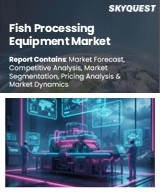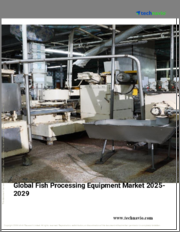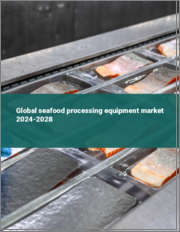
|
시장보고서
상품코드
1666000
세계의 해산물 가공 장비 시장 규모, 점유율, 성장 분석 : 기기 유형별, 자동화 레벨별, 용도별, 최종 용도별, 지역별 - 산업 예측(2025-2032년)Seafood Processing Equipment Market Size, Share, and Growth Analysis, By Equipment Type (Slaughtering Equipment, Smoking Equipment), By Automation level (Manual, Semi-Automatic), By Application, By End Use, By Region - Industry Forecast 2025-2032 |
||||||
세계 해산물 가공 장비 시장 규모는 2023년 31억 달러로 평가되었습니다. 2024년 32억 2,000만 달러에서 2032년에는 43억 4,000만 달러로 성장할 것으로 예상되며, 예측 기간(2025-2032년) 동안 3.8%의 연평균 복합 성장률(CAGR)을 보일 전망입니다.
세계 해산물 시장은 인구 증가, 식습관의 변화, 수산물, 특히 오메가3 지방산의 영양학적 이점에 대한 인식이 높아짐에 따라 급성장하고 있습니다. 이러한 수요의 급증으로 인해 고급 가공 솔루션이 필요하며, 수산물에 대한 소비자의 신뢰를 높이기 위한 규제 강화로 인해 더욱 가속화되고 있습니다. 소득 수준 상승, 도시화, 북미, 아시아태평양 등의 지역에서의 건강 인식 향상도 해산물 가공 장비의 성장을 가속하고 있습니다. 세계 아쿠아틱 프랙티스 얼라이언스(GAA)는 엄격한 우수 아쿠아틱 프랙티스(Best Aquatic Practice, BAP) 인증 기준을 시행하고 있으며, 제조업체들에게 맞춤형 장비에 대한 투자를 요구하고 있습니다. 단백질 소비가 증가하고 양식 수요가 확대됨에 따라 시장 환경은 여전히 양호한 편이며, 밸류체인 전반에 걸쳐 식품 안전 규정 준수의 중요성이 강조되고 있습니다.
목차
서론
- 조사 목적
- 조사 범위
- 정의
조사 방법
- 정보 조달
- 2차와 1차 데이터 방법
- 시장 규모 예측
- 시장 전제조건과 제한
주요 요약
- 세계 시장 전망
- 공급과 수요 동향 분석
- 부문별 기회 분석
시장 역학과 전망
- 시장 개요
- 시장 규모
- 시장 역학
- 성장 촉진요인과 기회
- 성장 억제요인과 과제
- Porter의 Five Forces 분석
주요 시장 인사이트
- 중요 성공 요인
- 경쟁 정도
- 주요 투자 기회
- 시장 생태계
- 시장의 매력 지수(2024년)
- PESTEL 분석
- 거시경제 지표
- 밸류체인 분석
- 가격 분석
해산물 가공 장비 시장 규모 : 장비 유형별&CAGR(2025-2032년)
- 시장 개요
- 도살 장비
- 훈제 장비
- 경화 및 충전 장비
- 내장 제거 장비
- 스케일링 장비
- 스키닝 장비
- 필렛 장비
- 뼈 제거 장비
- 기타
해산물 가공 장비 시장 규모 : 자동화 레벨별&CAGR(2025-2032년)
- 시장 개요
- 수동
- 반자동
- 완전 자동
해산물 가공 장비 시장 규모 : 용도별&CAGR(2025-2032년)
- 시장 개요
- 냉동 해산물
- 훈제 해산물
- 통조림 해산물
- 건조 어개류
- 연육(surimi) 해산물
- 기타
해산물 가공 장비 시장 규모 : 최종 용도별&CAGR(2025-2032년)
- 시장 개요
- 해산물 가공 공장
- 레스토랑 및 푸드서비스
- 소매
- 기타
해산물 가공 장비 시장 규모 : 지역별&CAGR(2025-2032년)
- 북미
- 미국
- 캐나다
- 유럽
- 독일
- 스페인
- 프랑스
- 영국
- 이탈리아
- 기타 유럽
- 아시아태평양
- 중국
- 인도
- 일본
- 한국
- 기타 아시아태평양
- 라틴아메리카
- 브라질
- 기타 라틴아메리카
- 중동 및 아프리카
- GCC 국가
- 남아프리카공화국
- 기타 중동 및 아프리카
경쟁 정보
- 주요 5개사 비교
- 주요 기업의 시장 포지셔닝(2024년)
- 주요 시장 기업이 채택한 전략
- 최근 시장 동향
- 기업의 시장 점유율 분석(2024년)
- 주요 기업 개요
- 기업 상세
- 제품 포트폴리오 분석
- 기업 부문별 점유율 분석
- 매출 전년대비 비교(2022-2024)
주요 기업 개요
- BAADER Group(Germany)
- JBT Corporation(USA)
- Optimar AS(Norway)
- Cabinplant A/S(Denmark)
- Skaginn 3 X(Iceland)
- GEA Group AG(Germany)
- Uni-Food Technic A/S(Denmark)
- Cretel NV(Belgium)
- Raytec Vision S.p.A.(Italy)
- Sepamatic GmbH(Germany)
- Trifisk Manufacturing(Canada)
- Bettcher Industries Inc(USA)
- Buhler Group(Switzerland)
- Carsoe Group A/S(Denmark)
- Coastline Equipment Inc(USA)
- Schaefer Technologies Inc(USA)
- Subzero(Grimsby) Ltd(UK)
- Arenco AB(Sweden)
- Durr AG(Germany)
결론과 제안
LSH 25.04.03Global Seafood Processing Equipment Market size was valued at USD 3.1 billion in 2023 and is poised to grow from USD 3.22 billion in 2024 to USD 4.34 billion by 2032, growing at a CAGR of 3.8% during the forecast period (2025-2032).
The global seafood market is witnessing significant growth driven by rising population, evolving dietary preferences, and heightened awareness of seafood's nutritional benefits, particularly omega-3 fatty acids. This surge in demand necessitates advanced processing solutions, spurred further by stricter regulations that enhance consumer trust in seafood products. Increasing income levels, urbanization, and improved health literacy in regions like Europe, North America, and Asia-Pacific are also propelling the growth of seafood processing equipment. The Global Aquatic Practices Alliance (GAA) enforces stringent Best Aquatic Practices (BAP) certification standards, compelling manufacturers to invest in custom equipment. As the protein consumption rises and aquaculture demand expands, market conditions remain favorable, emphasizing the importance of compliance with food safety regulations across the value chain.
Top-down and bottom-up approaches were used to estimate and validate the size of the Global Seafood Processing Equipment market and to estimate the size of various other dependent submarkets. The research methodology used to estimate the market size includes the following details: The key players in the market were identified through secondary research, and their market shares in the respective regions were determined through primary and secondary research. This entire procedure includes the study of the annual and financial reports of the top market players and extensive interviews for key insights from industry leaders such as CEOs, VPs, directors, and marketing executives. All percentage shares split, and breakdowns were determined using secondary sources and verified through Primary sources. All possible parameters that affect the markets covered in this research study have been accounted for, viewed in extensive detail, verified through primary research, and analyzed to get the final quantitative and qualitative data.
Global Seafood Processing Equipment Market Segments Analysis
Global Seafood Processing Equipment Market is segmented by Equipment Type, Automation level, Application, End Use and region. Based on Equipment Type, the market is segmented into Slaughtering Equipment, Smoking Equipment, Curing and Filling Equipment, Gutting Equipment, Scaling Equipment, Skinning Equipment, Filleting Equipment, Deboning Equipment and Others. Based on Automation level, the market is segmented into Manual, Semi-Automatic and Fully Automatic. Based on Application, the market is segmented into Frozen Seafood, Smoked Seafood, Canned Seafood, Dried Seafood, Surimi Seafood and Others. Based on End Use, the market is segmented into Seafood Processing Plants, Restaurants & Foodservice, Retail and Others. Based on region, the market is segmented into North America, Europe, Asia Pacific, Latin America and Middle East & Africa.
Driver of the Global Seafood Processing Equipment Market
A significant factor propelling the Global Seafood Processing Equipment market is the rising consumption of fresh seafood, which is influenced by evolving dietary preferences and a growing awareness of health benefits. Additionally, the demand for seafood in developing regions like Asia-Pacific and Latin America has surged, fueled by urbanization and rising disposable incomes. This trend is further supported by advancements in refrigeration, filleting, and packaging technologies designed to cater to these increasing demands, resulting in the widespread adoption of innovative seafood processing technologies across the globe. These dynamics collectively contribute to the ongoing growth of the market.
Restraints in the Global Seafood Processing Equipment Market
A major constraint in the Global Seafood Processing Equipment market is the substantial investment required for both the acquisition and upkeep of advanced processing technology. This financial burden poses a particular challenge for small and medium-sized enterprises (SMEs), as these modern systems often necessitate considerable capital outlay. Furthermore, the ongoing need for maintenance, repairs, and specialized labor to effectively operate these machines adds to the overall expenditure, thereby constraining growth opportunities in industries that operate on lower cost margins. As a result, many potential market players may find it difficult to enter or expand within this competitive landscape.
Market Trends of the Global Seafood Processing Equipment Market
The Global Seafood Processing Equipment market is witnessing a significant trend towards the integration of automation and smart technology, revolutionizing traditional processing methods. With advanced features such as IoT connectivity, data analytics, and real-time monitoring, these innovations are enhancing operational efficiency, consistency, and sustainability. Companies are increasingly adopting artificial intelligence and machine learning to optimize workflows, thereby decreasing waste and reducing reliance on manual labor. This technological shift not only streamlines processes but also aligns with global sustainability goals, positioning automation as a key driver for business growth in the seafood processing equipment sector going forward.
Table of Contents
Introduction
- Objectives of the Study
- Scope of the Report
- Definitions
Research Methodology
- Information Procurement
- Secondary & Primary Data Methods
- Market Size Estimation
- Market Assumptions & Limitations
Executive Summary
- Global Market Outlook
- Supply & Demand Trend Analysis
- Segmental Opportunity Analysis
Market Dynamics & Outlook
- Market Overview
- Market Size
- Market Dynamics
- Drivers & Opportunities
- Restraints & Challenges
- Porters Analysis
- Competitive rivalry
- Threat of substitute
- Bargaining power of buyers
- Threat of new entrants
- Bargaining power of suppliers
Key Market Insights
- Key Success Factors
- Degree of Competition
- Top Investment Pockets
- Market Ecosystem
- Market Attractiveness Index, 2024
- PESTEL Analysis
- Macro-Economic Indicators
- Value Chain Analysis
- Pricing Analysis
Global Seafood Processing Equipment Market Size by Equipment Type & CAGR (2025-2032)
- Market Overview
- Slaughtering Equipment
- Smoking Equipment
- Curing and Filling Equipment
- Gutting Equipment
- Scaling Equipment
- Skinning Equipment
- Filleting Equipment
- Deboning Equipment
- Others
Global Seafood Processing Equipment Market Size by Automation level & CAGR (2025-2032)
- Market Overview
- Manual
- Semi-Automatic
- Fully Automatic
Global Seafood Processing Equipment Market Size by Application & CAGR (2025-2032)
- Market Overview
- Frozen Seafood
- Smoked Seafood
- Canned Seafood
- Dried Seafood
- Surimi Seafood
- Others
Global Seafood Processing Equipment Market Size by End Use & CAGR (2025-2032)
- Market Overview
- Seafood Processing Plants
- Restaurants & Foodservice
- Retail
- Others
Global Seafood Processing Equipment Market Size & CAGR (2025-2032)
- North America (Equipment Type, Automation level, Application, End Use)
- US
- Canada
- Europe (Equipment Type, Automation level, Application, End Use)
- Germany
- Spain
- France
- UK
- Italy
- Rest of Europe
- Asia Pacific (Equipment Type, Automation level, Application, End Use)
- China
- India
- Japan
- South Korea
- Rest of Asia-Pacific
- Latin America (Equipment Type, Automation level, Application, End Use)
- Brazil
- Rest of Latin America
- Middle East & Africa (Equipment Type, Automation level, Application, End Use)
- GCC Countries
- South Africa
- Rest of Middle East & Africa
Competitive Intelligence
- Top 5 Player Comparison
- Market Positioning of Key Players, 2024
- Strategies Adopted by Key Market Players
- Recent Developments in the Market
- Company Market Share Analysis, 2024
- Company Profiles of All Key Players
- Company Details
- Product Portfolio Analysis
- Company's Segmental Share Analysis
- Revenue Y-O-Y Comparison (2022-2024)
Key Company Profiles
- BAADER Group (Germany)
- Company Overview
- Business Segment Overview
- Financial Updates
- Key Developments
- JBT Corporation (USA)
- Company Overview
- Business Segment Overview
- Financial Updates
- Key Developments
- Optimar AS (Norway)
- Company Overview
- Business Segment Overview
- Financial Updates
- Key Developments
- Cabinplant A/S (Denmark)
- Company Overview
- Business Segment Overview
- Financial Updates
- Key Developments
- Skaginn 3X (Iceland)
- Company Overview
- Business Segment Overview
- Financial Updates
- Key Developments
- GEA Group AG (Germany)
- Company Overview
- Business Segment Overview
- Financial Updates
- Key Developments
- Uni-Food Technic A/S (Denmark)
- Company Overview
- Business Segment Overview
- Financial Updates
- Key Developments
- Cretel NV (Belgium)
- Company Overview
- Business Segment Overview
- Financial Updates
- Key Developments
- Raytec Vision S.p.A. (Italy)
- Company Overview
- Business Segment Overview
- Financial Updates
- Key Developments
- Sepamatic GmbH (Germany)
- Company Overview
- Business Segment Overview
- Financial Updates
- Key Developments
- Trifisk Manufacturing (Canada)
- Company Overview
- Business Segment Overview
- Financial Updates
- Key Developments
- Bettcher Industries Inc (USA)
- Company Overview
- Business Segment Overview
- Financial Updates
- Key Developments
- Buhler Group (Switzerland)
- Company Overview
- Business Segment Overview
- Financial Updates
- Key Developments
- Carsoe Group A/S (Denmark)
- Company Overview
- Business Segment Overview
- Financial Updates
- Key Developments
- Coastline Equipment Inc (USA)
- Company Overview
- Business Segment Overview
- Financial Updates
- Key Developments
- Schaefer Technologies Inc (USA)
- Company Overview
- Business Segment Overview
- Financial Updates
- Key Developments
- Subzero (Grimsby) Ltd (UK)
- Company Overview
- Business Segment Overview
- Financial Updates
- Key Developments
- Arenco AB (Sweden)
- Company Overview
- Business Segment Overview
- Financial Updates
- Key Developments
- Durr AG (Germany)
- Company Overview
- Business Segment Overview
- Financial Updates
- Key Developments



















